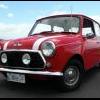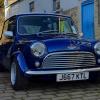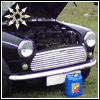
There seems to be a lot of people asking about this light/switch so hopefully people can be pointed here!
This is based on 1982 Australian assembled 998cc mini - however the all aspects should apply to other countries.
The system consists of a brake fluid level switch incorporated into the brake master cylinder cap and a dashboard switch with warning light. When your fluid level drops too low (adjustable) the red light comes on inside the switch on the dashboard to warn you. Manual states, pull over/stop asap and rectify before driving if this happens. The switch is meant to have a test function - press the switch and if the system is working correctly the light should illuminate. The switch is a self returning sprung rocker with light.
First of all, I inspected the fluid filler cap to find the metal tags inside have corroded away to nothing. I rebuilt the switch using a left over CV boot clip - perfect width and easily bent to shape. Following pictures shows the cap after being repaired:
Lever off the top with a flat head screwdriver:

New contacts:

Shows float:


The switch works using a float with a brass disc that touches the tabs when the fluid level drops.
Next step was the switch and the wiring in the car.
Using a test meter and bit of luck I was able to identify the wires. I used more of the CV boot clip to simulate the fluid switch being 'on' and giving me a complete circuit for the lamp inside the car:

The wires attached to the back of the switch:
Pink fly wire is positive feed, black fly wire is direct from brake switch. Two connector block contacts are earth and direct line from brake switch.

Inside the switch with the front removed showing the bulb and connections.

Back half of the switch:

My rather crude diagram of where the wires go according to MY tests. This does not give me a working test switch - when the fluid runs low, you have to push the switch down for the light to turn on! If the fluid is fine, pushing the switch does not light the bulb. To fix this I turned the white block+spring around (Fig 8), making the switch permanently 'on' - this means I cannot 'test' the system using the button as it does not move. A better way I have now of testing the system is on the master cylinder (Fig 4) using the small 'dimple' in the centre of the cap, pushing it in simulates loss of fluid and turns the warning light on.

If you see this your in trouble!!!

Edited by Disco Dan, 03 March 2009 - 02:50 AM.





















